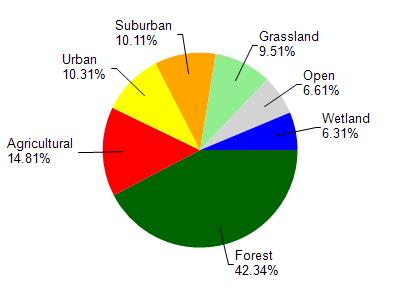La Crosse
Yes
No
No
Fish and Aquatic Life
Overview
Eggens Coulee Creek, located in central La Crosse County, flows for approximately 1.4 miles in a southerly direction before reaching Neshonoc Creek. It has a moderate gradient of 50 feet per mile and drains steep forested hills and agricultural valley land. Eggens Coulee Creek is a Class II trout stream for its entire length.
A 1971 fishery survey documented brown trout, spottail shiner, sand shiner and Johnny darter. The stream bottom was largely comprised of sand with lesser amounts of silt and gravel. An updated fish and habitat survey of Eggens Coulee Creek is necessary to determine its current status. This stream has not been stocked by WDNR since the early 1960s. Access to Eggens Coulee Creek is from two road crossings.
Date 2002
Author Aquatic Biologist
Condition
Wisconsin has over 84,000 miles of streams, 15,000 lakes and milllions of acres of wetlands. Assessing the condition of this vast amount of water is challenging. The state's water monitoring program uses a media-based, cross-program approach to analyze water condition. An updated monitoring strategy (2015-2020) is now available. Compliance with Clean Water Act fishable, swimmable standards are located in the Executive Summary of Water Condition in 2018. See also the 'monitoring and projects' tab.
Reports
Management Goals
Wisconsin's Water Quality Standards provide qualitative and quantitative goals for waters that are protective of Fishable, Swimmable conditions [Learn more]. Waters that do not meet water quality standards are considered impaired and restoration actions are planned and carried out until the water is once again fishable and swimmable
Management goals can include creation or implementation of a Total Maximum Daily Load analysis, a Nine Key Element Plan, or other restoration work, education and outreach and more. If specific recommendations exist for this water, they will be displayed below online.
Monitoring
Monitoring the condition of a river, stream, or lake includes gathering physical, chemical, biological, and habitat data. Comprehensive studies often gather all these parameters in great detail, while lighter assessment events will involve sampling physical, chemical and biological data such as macroinvertebrates. Aquatic macroinvertebrates and fish communities integrate watershed or catchment condition, providing great insight into overall ecosystem health. Chemical and habitat parameters tell researchers more about human induced problems including contaminated runoff, point source dischargers, or habitat issues that foster or limit the potential of aquatic communities to thrive in a given area. Wisconsin's Water Monitoring Strategy was recenty updated.
Grants and Management Projects
| Project Name (Click for Details) | Year Started |
|---|
|
|
Monitoring Projects
| WBIC | Official Waterbody Name | Station ID | Station Name | Earliest Fieldwork Date | Latest Fieldwork Date | View Station | View Data |
|---|
| 1653300 | Eggens Coulee Creek | 10013133 | Eggen Coulee Creek St.1-05 2 Culverts On Eggens Coulee Road | 1/1/2015 | 1/1/2015 | Map | Data |
| 1653300 | Eggens Coulee Creek | 10013941 | Eggens Coulee Creek Station 1 - T17n R6w S15 Sw 1/4 Se 1/4 | | | Map | Data |
| 1653300 | Eggens Coulee Creek | 10013942 | Eggens Coulee Creek Station 2 - T17n R6w S15 Se1/4 Ne 1/4 | | | Map | Data |
|

Watershed Characteristics
Eggens Coulee Creek is located in the Lower La Crosse River watershed which is 145.46 mi². Land use in the watershed is primarily forest (42.30%), agricultural (14.80%) and a mix of urban (10.30%) and other uses (32.50%). This watershed has 295.20 stream miles, 1,187.12 lake acres and 5,641.64 wetland acres.
Nonpoint Source Characteristics
This watershed is ranked Medium for runoff impacts on streams, Not Ranked for runoff impacts on lakes and Low for runoff impacts on groundwater and therefore has an overall rank of Low. This value can be used in ranking the watershed or individual waterbodies for grant funding under state and county programs.However, all waters are affected by diffuse pollutant sources regardless of initial water quality. Applications for specific runoff projects under state or county grant programs may be pursued. For more information, go to surface water program grants.